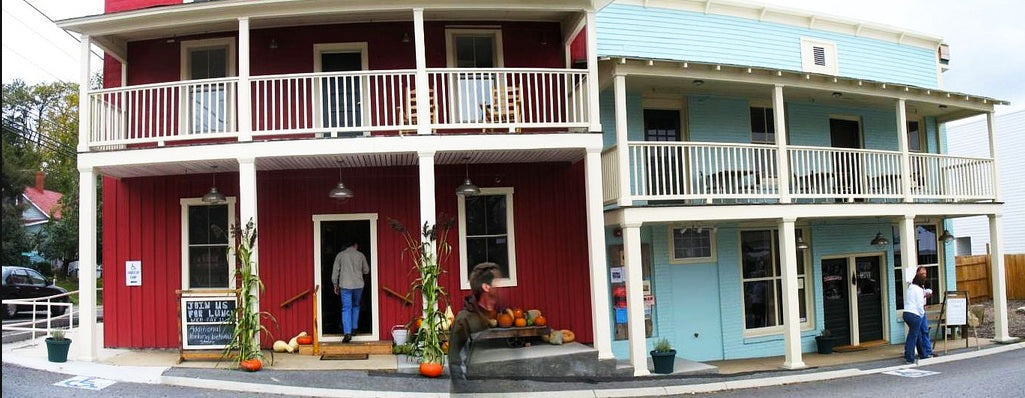
The book is a charmer, and, by all accounts, so is the couple. I particularly like this 2008 interview, in which Kingsolver gets big laughs talking about turkey sex and the zucchini industrial complex.
Apparently, though, it takes more than a winning personality and literary fame to build a locally grown movement in Meadowview, Virginia. A recent article in The New York Times focused on Hopp's struggle to attract diners to the Harvest Table, which promotes itself as "the most dedicated farm-to-table restaurant in Southwestern Virginia."
"The 50-seat Harvest Table has not yet turned a profit," said The Times, "Over the past several years, it has struggled to build a fan base among the area’s predominantly blue-collar residents for whom the average annual income is $15,750, and many of whom view local and organic food as out of reach."
At first, I was surprised to read this. Given the proliferation of farm stands and farmers' markets throughout Southwest Virginia, this restaurant seemed like a natural extension. People buy locally grown produce to eat at home; why wouldn't they want it when they eat out?
Then I took a closer look at the restaurant. It's a "downtown" restaurant, located in a renovated building in Meadowview's town center. It serves frittatas and artisan cheese plates in a community that is not only low income but rural. I started to wonder if its challenges are as much cultural as they are economic.
I should pause here and note that the title of The New York Times article is "Local Food Has Been No Easy Sell in Appalachia." Clearly, it hasn't been an easy sell in Meadowview, Virginia. To find out about the rest of the region, I called a couple of other restaurants that promote their commitment to locally grown food.
[caption id="attachment_4049" align="alignleft" width="234"]
 Diners at Local Roots[/caption]
Diners at Local Roots[/caption]First, I spoke with Brian Sallade, General Manager at Local Roots in Roanoke. This restaurant is also located in Southwest Virginia but in a metro area of about 300,000 people. I asked Sallade, point blank, "Can you make it as a restaurant serving locally grown food in Appalachia?"
"I definitely think so," he said, noting that it's a new idea but that interest is growing. "There are definitely more people on board. Some people say that they will only eat at our restaurant because they know where their food is coming from."
The Local Roots menu is actually a little more costly than the menu at Harvest Table. At Local Roots, entrees start at $17. At Harvest Table, you can get a burger platter for $7. The Roanoke-based restaurant, however, has the advantage of a larger, more diverse customer base. Sallade said that it's not unusual to have business people dine in groups of ten or more. That's not likely to happen at Harvest Table.
Hoping to get another small town perspective, I rang Leslie Hotaling, Co-owner of Panorama at the Peak in the West Virginia arts town of Berkeley Springs. With clinking glass and the bustle of a busy dinning room in the background, she said, "There's a resurgence of diners looking for locally grown food. I think the days of processed food are coming to an end."
[caption id="" align="alignright" width="240"]
 Salad at Panorama at the Peak[/caption]
Salad at Panorama at the Peak[/caption]Her bold outlook seems to be paying off. Panorama at the Peak is in its sixth year and was just awarded the Snail of Approval award from Slow Food D.C. This recognition made me wonder if the restaurant's proximity to D.C. underpins its success. Hotaling says that it's a factor, but that "local guests are 75 percent of our clientele."
This brings me back to the cultural question. In Appalachia, you have both locavores and what I'll call McDonaldvores. The former seek out locally grown food or are, at least, open to it when they find it. There seem to be enough of them in Appalachian cities and in funky towns like Berkeley Springs to sustain local food restaurants.
Meadowview, by contrast, sounds like the land of McDonaldvores, people who'd rather eat at a restaurant with a known brand and ample parking. Many of my relatives fall into this category. When I visit home in the Blue Ridge, dining out can be a source of tension. I usually advocate for a locally-owned downtown restaurant. They want to hit the IHOP. It's not because they don't see the value of keeping dollars local. They just want to eat somewhere familiar, where they don't have to jockey for parking, and where they see themselves fitting in.
I think that this distinction is missed by The New York Times. It pins the troubles at Harvest Table on first, the cost of the restaurant's food and second, some Appalachian aversion to eating local.
The article actually gets a little urban-uppity when it says "in the heart of Appalachia, where there isn’t a critical mass of suppliers or customers for whom the term 'locavore' rolls naturally off the tongue, the restaurant remains something of a curiosity" and that Harvest Table would be "an instant hit in a progressive, urban enclave like Brooklyn or Berkeley, Calif."
I posit that the restaurant would also be a hit in Roanoke, Berkeley Springs, Asheville, Berea, or any other Appalachian locale with locavore tendencies. You don't have to go to New York or California to find a market.
What's more, I would wager that even in Meadowview, plenty of people spend $7 on a burger or more. They just do so at Applebee's or Outback Steak House, not at an independently owned restaurant in a historic building with a vegetable garden out back. As much I love spots like these, they're not for everyone.
So the challenge for Hopp and maybe for the local foods movement in general is this--how do you get folks who'll buy tomatoes at a farm stand (which is just about everyone in Southwest Virginia) to stop at a restaurant that specializes in locally grown food?
Do you need to reposition the marketing, downplaying "locally grown" and playing-up more mainstream attributes like "convenience" or "family friendly"?
Should locally grown restaurants try relocating to malls?
Does someone need to launch a locally grown franchise with consistent branding, major ad buys and big signs?
What will it take to transition the locally grown movement from a niche concept that works in select markets to a mainstream option that thrives anywhere?
I don't begin to have the answers, but I bet you can think of some. Share your ideas for getting more people to eat local, or if you don't think it's going to happen, tell us why.














